Sinister Sudoku (24 page)
Authors: Kaye Morgan

STEP 4
We’ve picked 6 as the new number to go with in Step 4. Looking at the lower left-hand box, we’ve created a hidden single for 6
1
using clues 6
2
, 6
3
, and 6
4
. Now look at the top center box. Clues take up four of the available spaces. The already placed 9 takes up a fifth space, and the placement of clue 6
2
prohibits 6s in the central row. This leaves only one available empty space, where we’ll place 6
5
. The central box in the puzzle has only one clue space and one space occupied with a 9. But the placement of clues around the box prohibit 6s in all but one space, where we’ve placed 6
6
.
1
using clues 6
2
, 6
3
, and 6
4
. Now look at the top center box. Clues take up four of the available spaces. The already placed 9 takes up a fifth space, and the placement of clue 6
2
prohibits 6s in the central row. This leaves only one available empty space, where we’ll place 6
5
. The central box in the puzzle has only one clue space and one space occupied with a 9. But the placement of clues around the box prohibit 6s in all but one space, where we’ve placed 6
6
.
Placing 6
7
as shown in the lower right-hand box prohibits 6s in the center column of the right-hand stack of boxes, but leaves some uncertainty in placing a 6 in either of the remaining columns. Let’s mark the possible locations for the time being and move on.
7
as shown in the lower right-hand box prohibits 6s in the center column of the right-hand stack of boxes, but leaves some uncertainty in placing a 6 in either of the remaining columns. Let’s mark the possible locations for the time being and move on.
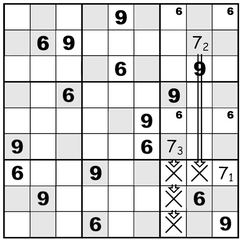
STEP 5
As more clues appear in the puzzle grid, we may be able to set up placements with fewer clues. Because of the existing 9s and the arrangement of clue spaces, we only need two clues to establish 7
1
as a hidden single in the lower right-hand box.
1
as a hidden single in the lower right-hand box.
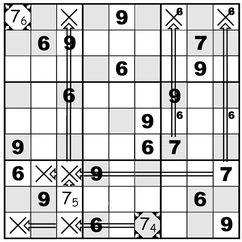
STEP 6
We’ll start off Step 6 by placing 7
4
in the bottom center box. Between the squares that this newly placed clue prohibits, and the squares prohibited by already placed clue 7
1
, there’s only one open space in the lower left-hand box available to place 7
5
.
4
in the bottom center box. Between the squares that this newly placed clue prohibits, and the squares prohibited by already placed clue 7
1
, there’s only one open space in the lower left-hand box available to place 7
5
.
Now take a look at Row 1 at the top of the puzzle. As the long arrows and “prohibited” signs show, 7s that have already been placed account for every open space in the row except for the very first one—and that’s where we’ll place 7
6
.
6
.
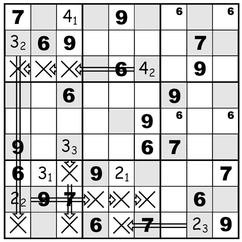
STEP 7
With Step 7, we’ll try to establish some other numbers on the grid. Working down the left-hand stack of boxes, we can set up a hidden single situation for 3
1
in the lower left-hand box by placing clues 3
2
and 3
3
as shown.
1
in the lower left-hand box by placing clues 3
2
and 3
3
as shown.
Then, running across the lowermost tier of boxes, placing clues 2
2
and 2
3
as shown prohibits all but one open space for 2
1
in the bottom center box.
2
and 2
3
as shown prohibits all but one open space for 2
1
in the bottom center box.
When we look at the upper left-hand corner box, we see that clue spaces and filled-in spaces allow us to use only one clue at 4
2
to place 4
1
at the top of the third column.
2
to place 4
1
at the top of the third column.
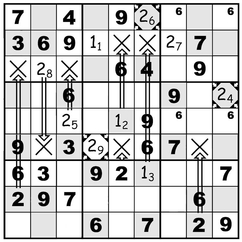
STEP 8
Let’s see how much farther we can take things by placing 2s. If we establish 2
4
in the clue space in the right-center box, we can place 2
5
in a legal space in the left-center box. The grid is beginning to get crowded now, so this may be the last of that sort of placement.
4
in the clue space in the right-center box, we can place 2
5
in a legal space in the left-center box. The grid is beginning to get crowded now, so this may be the last of that sort of placement.
Putting 2
6
in the upper middle box pretty much forces the placement of 2
7
—that’s the only legal space in the upper right-hand box, since the only empty spaces in the left top box are in the third row. And looking at that upper-left box, we see that existing clues prohibit 2s in all but one space on that row, so we can place 2
8
.
6
in the upper middle box pretty much forces the placement of 2
7
—that’s the only legal space in the upper right-hand box, since the only empty spaces in the left top box are in the third row. And looking at that upper-left box, we see that existing clues prohibit 2s in all but one space on that row, so we can place 2
8
.
Next, let’s look at Row Six. Existing clues prohibit the placement of 2s in every blank space but one, so that fixes the place for 2
9
. Now we’ve placed all the 9s and all the 2s.
9
. Now we’ve placed all the 9s and all the 2s.
Let’s look at the top middle box and see if we can start placing 1s. Filled-in spaces and clues leave only the middle row clear. We can easily set 1
1
in place with clues at 1
2
and 1
3
.
1
in place with clues at 1
2
and 1
3
.
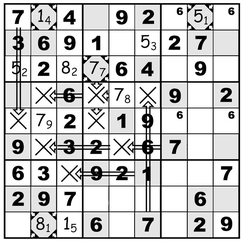
STEP 9
In Step 9, we’ll start off trying to place some more 1s. Establishing 1
4
in the clue space in the upper left-hand box, we can fix 1
5
in the lower left box. While there are two open spaces in the third column in the box, an existing clue prohibits the placement of 1s except where shown.
4
in the clue space in the upper left-hand box, we can fix 1
5
in the lower left box. While there are two open spaces in the third column in the box, an existing clue prohibits the placement of 1s except where shown.
Moving in reverse now, the placement of 8
1
in the center column of the lower left box forces 8
2
in the upper left—that’s the only legal space where we can put an eight.
1
in the center column of the lower left box forces 8
2
in the upper left—that’s the only legal space where we can put an eight.
Let’s start off the 5s by placing 5
1
on the clue space in the upper right-hand box. Finding 5
2
is pretty obvious— it’s the only empty space in the upper-left box. And let’s place 5
3
on a legal space in the top-center box before it gets too crowded.
1
on the clue space in the upper right-hand box. Finding 5
2
is pretty obvious— it’s the only empty space in the upper-left box. And let’s place 5
3
on a legal space in the top-center box before it gets too crowded.
Placing 7
7
in the clue space in the top-center box prohibits 7s in two blank spaces in the central box. Already placed clues eliminate two spaces more. Only one legal space remains, and that’s where we’ve put 7
8
. This leaves the left-center box as the only one without a 7. Existing clues (including the just placed 7
8
) eliminate all the open spaces in the box except for one. Placing 7
9
there lets us complete another set of numbers.
7
in the clue space in the top-center box prohibits 7s in two blank spaces in the central box. Already placed clues eliminate two spaces more. Only one legal space remains, and that’s where we’ve put 7
8
. This leaves the left-center box as the only one without a 7. Existing clues (including the just placed 7
8
) eliminate all the open spaces in the box except for one. Placing 7
9
there lets us complete another set of numbers.
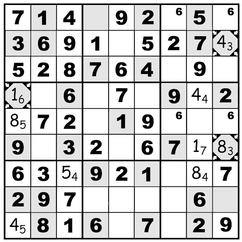
STEP 10
In Step 10, we’ll need to fix a couple more clues to proceed. Setting 8
3
in the right-bottom box fixes 8
4
in the box below—that’s the only legal space left in Column Eight. We can also place an 8 in the left-center box. The rightmost column in the box is completely filled, and an existing 8 in the box below eliminates the empty spaces in the center column. That leaves one remaining empty space, where we put 8
5
. In that same box, placing 1
6
in a clue space, along with the existing clue in the central box, fixes 1
7
in the center-right subgrid.
3
in the right-bottom box fixes 8
4
in the box below—that’s the only legal space left in Column Eight. We can also place an 8 in the left-center box. The rightmost column in the box is completely filled, and an existing 8 in the box below eliminates the empty spaces in the center column. That leaves one remaining empty space, where we put 8
5
. In that same box, placing 1
6
in a clue space, along with the existing clue in the central box, fixes 1
7
in the center-right subgrid.
Let’s look at the situation for 4s. We’d placed only two up to now, in the top-left and top-center boxes. However, since we’ve placed some other clues in the top-right box, there’s only one legal space free to take a 4, so 4
3
goes in the clue space as shown.
3
goes in the clue space as shown.
There are only two available legal spaces for 4s in the Column Eight so let’s fix one with 4
4
. And there’s only one space left in Column One, and that takes 4
5
.
4
. And there’s only one space left in Column One, and that takes 4
5
.
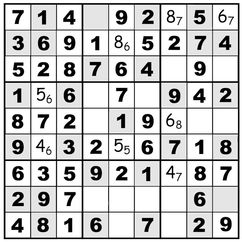
STEP 11
To start off Step 11, let’s look at the intersection of Column Two and Row Six. If we were to start looking for candidates, we’d find that the space can only take a 4 or a 5. So can the other remaining space. However, that space intersects a 4 in the right-middle box. That means we can place 5
6
and 4
6
as shown, as well as 5
5
.
6
and 4
6
as shown, as well as 5
5
.
In Row Two, there’s only one space left, which takes 8
6
. An existing 8 in the top left box, plus clues in the middle-right and bottom-right boxes zero in on one possible space for an 8 in the upper-right box. That’s where we’ve placed 8
7
. That space, by the way, is one of the four “possible” spaces for 6s. An 8 in that space means a 6 in the space at the end of the line, shown as 6
7
. It also places a 6 two spaces to the left and four spaces down, 6
8
.
6
. An existing 8 in the top left box, plus clues in the middle-right and bottom-right boxes zero in on one possible space for an 8 in the upper-right box. That’s where we’ve placed 8
7
. That space, by the way, is one of the four “possible” spaces for 6s. An 8 in that space means a 6 in the space at the end of the line, shown as 6
7
. It also places a 6 two spaces to the left and four spaces down, 6
8
.
Other books
Performance Anomalies by Victor Robert Lee
Trouble in July by Erskine Caldwell
Rituals by Cees Nooteboom
B00B9FX0MA EBOK by Davies, Anna
Killing Woods by Lucy Christopher
The Dress Shop of Dreams by Menna van Praag
Proof of Heaven by Alexander III M.D., Eben
Collected Short Stories by Michael McLaverty
6 Grounds for Murder by Kate Kingsbury
